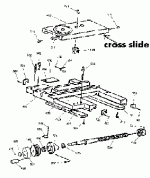I'll try to help you. The slide is the basic generic design that many lathes use.
I can not make out the bearing pack very well, but I wouldn't worry too much.
1. remove the handle on the cross slide
2. there is a bearing pack of somekind right behind the handle. Usually held in place by either a Timken bearing nut, Bearhug bearing nut, or a flat looking disc with holes drill in it for a spanner wrench. I would not remove any of these nuts with a hammer and punch, unless you like buying new parts
3. once the bearing pack assembly is removed (keep track of the direct the bearing went on the cross feed screw as this is very important)
4. ontop the slide you will find two or maybe three screws that attach the cross feed screw's nut to the top of the slide. Remove them. Next remove all the gibs, and mark each one for where they came from as in many cases they look the same.
5. I could not tell very well if the was a second bearing pack on the rear of the lead screw. If there is, it will have tobe removed just like the other.
6. Now you should be able to slide the cross slide off the saddle towards the operator's side of the machine
7. you can now remove the leadscrew
Being as the lathe was in a serious wreck, you will want to lightly stone the saddle and slides bearing surfaces with a very fine brown india stone (I'll fine the correct numbers for you). Now you should set the lead screw inside a matching pair of vee blocks on a surface plate. Rotate the screw and check with a dial indicator to see if it's still strait
(less than .0005" TIR). If the screw is strait you'll be OK assuming the nut is undamaged. If it shows a lot of slop in it (can you wiggle it sideways?), I'd replace them both (buy two nuts). Now being as we've taken a serious hit on the slide, I'd go out and buy new bearings (all you need is ABEC 5's so don't let them try to sell you sevens or even nines). Stone the gibs very lightly (are they showing a lot of wear?)
NOW for the bad part! If the head stock took a major hit, it will probably have to be realigned. Does the chuck open and close freely? With no tight spots? If the headstock is cast with the frame you'll be OK as long as you didn't hurt the spindle bearings. Assuming the chuck is OK (check the jaws very closely as they'll probably have to be recut with a spider). Find something that is very smooth and round (I like Thompson rod but drill rod will do in a pinch) and about 1.50" in diameter. You'll need at least a foot long piece and 18" is far better. Chuck it up in the lathe just like you were going to make a cut on it. You'll need a good wand type .0005" dial indicator (I prefer Interrapid, but they don't come cheap). By hand rotate the chuck till you get to the idicators low point of travel, and then set a zero. Now rotate the the chuck slowly till you've made at least four or five revolutions. Hopefully it will read less than .0005". If you have a good tenth indicator now is the time to use it. While rotating the chuck by hand, do you feel any metalic clocks or a tight spot? If you do you got problems. Should everything feel and look go so far, then lets reassemble the slide and screw and nut. Everybody has their own way of tightening the gibs, and here's what I do. First I'll crank the cross slide back and fourth a couple inches while pushing the gibs in with my thumb (not too tight now). Some cross slides have screws on both ends of the cross slide for the gibs. If so you got off lucky assuming you did not remove them. After you have the gibs in all the way and locked down, take a .0005" indicator and put it ontop the slide with the indicator reading agains the saddle. If the reading changles a lot when you crank the slide tighten the gibs till it quits moving (not too tight). when doing this you only need to move the slide a quarter inch at most. Now it's time to adjust the backlast out of the lead screw is you have the three screw nut. The center screw is the adjustment. Otherwise I'd use plastic shim stock between the slide and the nut to push it down (some actually work just the opposite of this, but are not common). After all is assembled lets put the Thompson rod back in the chuck one more time. Rotate it to make sure it's chucked up nice and square. Now you want to sweep the top of the rod with an indicator You may find that you need a gib adjustment on the saddle as well. Make several sweeps along the top without moving anything, and write down what you find. Rotate the chuck 180 degrees and do the samething. Now you know the true error in the chuck as well as the alignment of the head stock. Next sweep the side the sameway. and rotate it. Hopefulling it will come out at less than .001" in 12". If not all is not lost, but the fix will take into another world of fixing machinery.
email me at
l1945@sbcglobal.net if you need more help, as I did this for a living half my life.
gary


